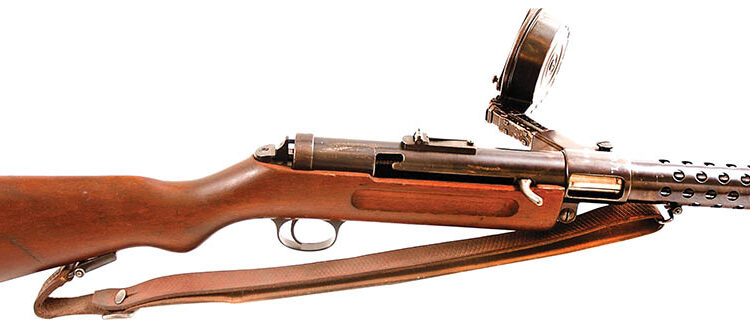By Frank Iannamico
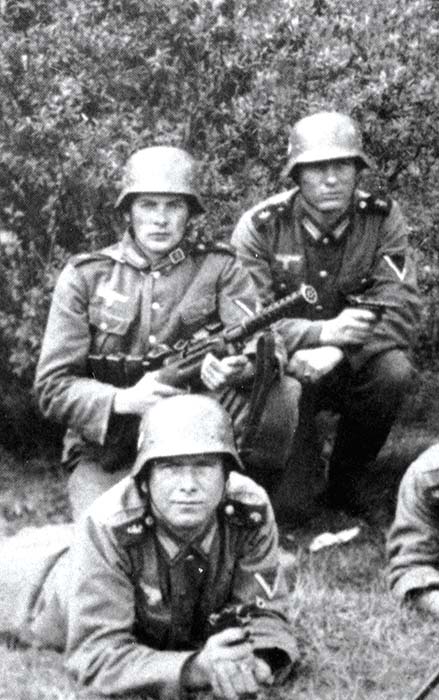
A belief commonly held among submachine gun historians is that the Italian Villar Perosa devised in 1915, was the very first submachine gun. This is to some extent true, but the Villar Perosa was originally manufactured to be mounted on aircraft or vehicles. The Villar Perosa was actually a scaled down machine gun, except that it used pistol caliber ammunition. Altering the Italian Villar Perosa into a personal shoulder fired weapon by adding a wooden stock, was done at a later date. So it remains controversial among historians as to which gun, the Villar Perosa or the German M.P. 18,I, was actually the first shoulder fired submachine gun. The Villar Perosa was originally chambered to fire the 9mm Glisenti cartridge, which is less powerful than the 9mm Parabellum round.
The requirements for a new type of weapon were set up by the German Rifle Testing Commission at Spandau in 1915. The using branches of the services wanted a lightweight, fully automatic, short range weapon. The proposed weapon had to be simple, robust and able to be easily carried by one man. Desired was a weapon that combined the handiness of a pistol, with the firepower of a machine gun. It was also requested that the new weapon to be chambered for the standard German pistol cartridge, the 9mm Parabellum. One of the early attempts at meeting these requirements was done by altering a long barreled Artillery Model of the 9mm Luger pistol. The modifications included a buttstock and adding a few internal parts to provide full-automatic capability. After an intense evaluation, the transformed Luger was deemed unsuitable for adoption. The weapon was considered to have too fast of a cyclic rate of fire and excessive muzzle climb. Adapting existing weapons to fulfill a specific requirement generally results in a compromise; an entirely new concept was needed.
By 1916, two German weapon designers, Andreas Schwarzlose of Berlin and Hugo Schmeisser of Suhl, both submitted prototype weapons that were deemed superior. Both of the weapons were thoroughly evaluated and tested. Schmeisser’s weapon was developed with the resources of the Waffenfabrik Theodor Bergmann, and was eventually chosen by the Commission in 1918. Schmeisser’s new weapon was designated as the Maschinenpistole (M.P.) 18,I. In 1918 the Prussian War Ministry ordered 50,000 of the new M.P. 18,I weapons.
The M.P. 18,I saw limited use with the German army in the final days of World War One. The 9mm weapon was issued to troops in 1918 to use for infiltrating and assaulting a dug-in enemy in their trenches. The standard bolt action service rifle was too awkward and slow firing for this style of close quarter combat. While the enemy would be using rifle-mounted bayonets to repel such an attack, the Germans would be using their rapid firing maschinenpistolen. The new German machine pistol was also useful for defending their trenches from similar close quarter assaults from the enemy. The troops using these tactics for assaulting the enemy trenches were known as Sturmtruppen, or Storm Troopers. These specially trained and motivated soldiers were armed with mortars, grenades, machine pistols and flame throwers, and would basically use concentrated firepower to open a narrow gap in the enemy’s line. After breaking through the defenses, regular infantry troops were then used to exploit the breach. These tactics were improved with the use of aerial reconnaissance and artillery support. Soon, with much protest from the Germans, Allied troops began to employ shotguns for repelling these close quarter assaults.
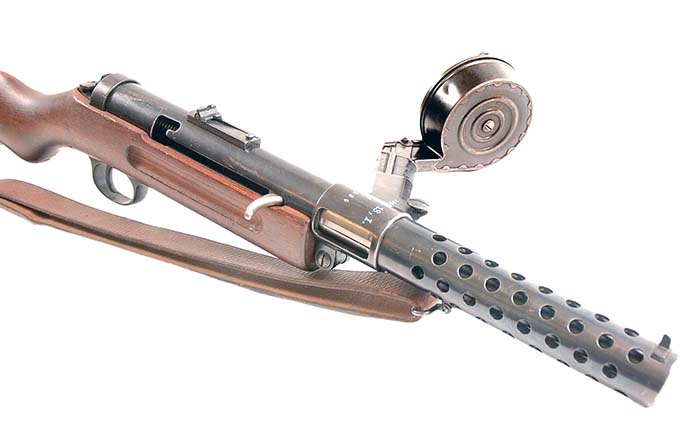
The M.P. 18,I machine pistol was affectionately nicknamed the Kugelspritze or bullet squirter by the German troops. Today’s common term “submachine gun” wouldn’t be used until American John Thompson coined the phrase in 1920 for his Thompson submachine gun. The term “submachine gun” was slow to catch on in Europe, and the nomenclature wasn’t used there until well after World War II. The basic design of the M.P. 18,I and its (box type) magazine would be very influential on many future weapons. The German M.P. 18,I was developed as a blowback operated, open bolt design. This new, revolutionary open bolt concept would soon be standard on submachine guns produced throughout the world.
Reportedly, Schmeisser originally designed the M.P. 18,I to feed cartridges from a 20-round box type magazine, however the German Rifle Commission wanted the weapon to utilize the existing high capacity 32-round Luger drum magazine. As a result of that directive, the production M.P. 18,I weapon utilized the same 32 round capacity Trommel magazin, or snail type drum magazine originally developed for the P.08 Luger pistols. An adapter sleeve was used on the magazine to keep the drum from being inserted too far into the magazine well and interfering with the operation of the breech bolt. The Luger drum magazine also required the magazine housing to be configured at the same 60-degree angle (rearward) as a P.08 Luger pistol grip in order to feed the cartridges properly. This odd magazine housing angle, and the weight (2.35 pounds loaded) of the magazine protruding horizontally from the left side of the receiver, made the M.P. 18,I awkward to handle. The heavy Luger drum magazine would prove to be the weak point of the M.P. 18,I machine pistol.

The M.P. 18,I machine pistol was a full-automatic only weapon, and fired at the relatively slow rate of 350-400 rounds per minute. An experienced shooter could easily accomplish single shots by careful trigger manipulation. A separate, moveable spring-loaded firing pin was used. A two-leaf flip style notch rear sight was fitted to the receiver tube. One leaf was calibrated for 100 meters, the second leaf for 200 meters. A very similar rear sight configuration would be used on the MP40. The front sight was an inverted V-blade dovetailed to the barrel jacket. The receiver was hinged at the front of the stock allowing it to tip up for easy disassembly and maintenance. A wooden carbine style stock with a semi pistol grip and grooved forearm was fitted. A sling swivel was attached to the underside of the barrel jacket, a rear swivel was attached by screws to the underside of the buttstock. The weapon’s overall length was 32.1 inches. The barrel was a six-groove, right hand twist, its length was 7.88 inches. The weight of the weapon with a loaded 32 round drum magazine was heavy at 11.61 pounds. The cartridge used in the weapon was the German Pistolenpatrone 08, better known as the 9mm Parabellum cartridge.
After the war ended, the design of the M.P. 18,I machine pistol was altered slightly by Schmeisser, in order to replace the troublesome and heavy Luger snail drum, with a box-type magazine. The new magazine was a double-stack, single-feed design. In order to fit the new magazine to the M.P. 18,I machine pistol, a new magazine housing also was developed and fitted to the gun at C.G. Haenel factory located in Suhl, Germany. The new re-designed magazine housing was marked “M.P. 18,I System Schmeisser”. The new magazines for the M.P. 18,I (modified) were manufactured in both 20 and 32 round configurations. In addition to the magazine housing and magazine, a new bolt safety was fitted and a lock was added to the barrel retaining screw.
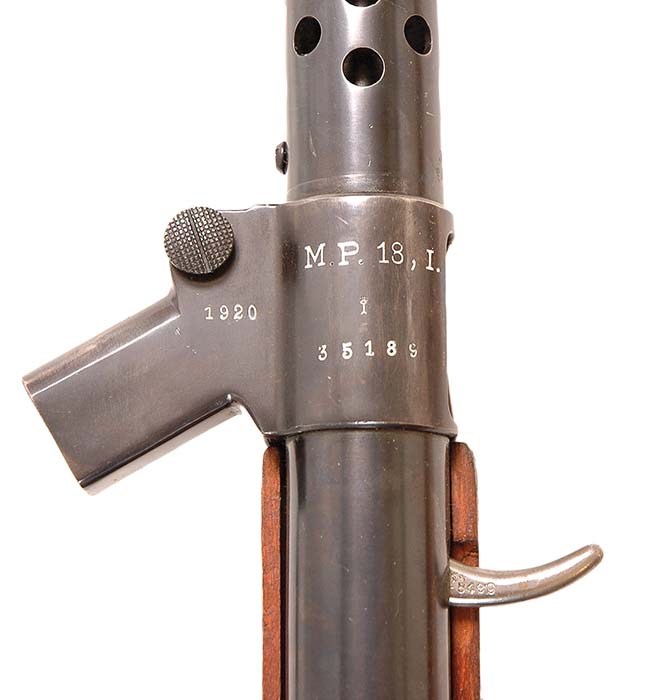
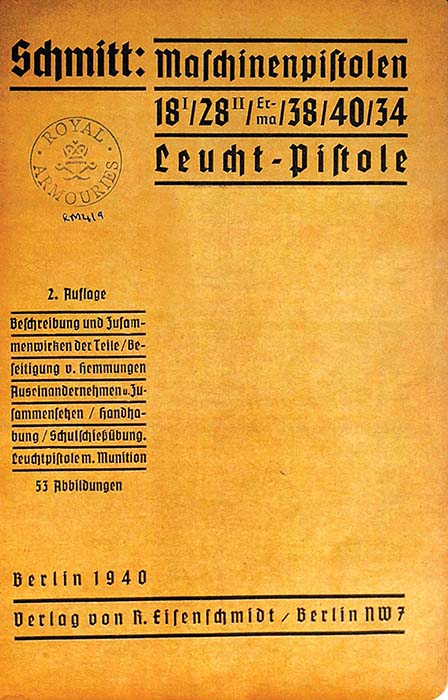
The double-stack single-feed design of the MP box magazines would prove to be responsible for many weapon malfunctions. This was especially true when the magazines were exposed to dust and dirt. Despite the problems encountered with the double-stack single-feed design, it was used, with a few notable exceptions, on virtually all World War II submachine gun designs that followed. The horizontal magazine position was also less than ideal. The advantage was that it allowed the shooter to get closer to the ground during a firefight, resulting in less exposure to enemy fire. The disadvantage was the weight of the loaded magazine protruding from the side of the weapon. The magazine mounted hanging in a horizontal position was also much more likely to cause cartridge-feeding problems.
After the conclusion of World War One, Germany was stripped of almost all of her weapons. Many of the World War One produced M.P. 18,I maschinenpistolen were seized and subsequently destroyed by the Allies. Germany was permitted by the treaty to maintain a 100,000 man Reichswehr or self-defense force. This defense force was very limited on what type of weapons they could be armed with. Issue of machine pistols was very restricted and subject to approval by the Allied Commission. The German police were also permitted to have limited use of machine pistols. The M.P. 18,I machine pistol would be one of the weapons they were issued to perform their duties. The post war issue M.P. 18,I weapons were marked with a 1920 date.
The German based Bergmann Company was forced to cease manufacture of the M.P. 18,I. The company negotiated a licensing agreement with the Schweizer Industrie Gesellschaft (SIG) to manufacture the M.P. 18,I in Neuhausen, Switzerland. The weapon was manufactured with the modified magazine housing and box style magazine into the 1920’s principally for foreign sales. The Swiss made M.P. 18,I was marketed as the Bergmann Machine Pistol, and was produced in 7.65mm Mauser, 7.63mm, 9mm Mauser and 9mm Parabellum. The weapons were distributed by the Swiss firm Societe Industrialle Suisse. The majority of the weapon’s sales were made to Japan chambered for the 7.63mm cartridge. The Japanese contract guns were designated as the Type BE. There were at least two variants of the Japanese contract guns. One style had a removable collar that fitted on the barrel jacket for mounting a Japanese service bayonet; the second type was made with and without the bayonet feature, and were marked with Japanese characters. Over 25,000 post WWI M.P. 18,I weapons (modified) were produced for export.
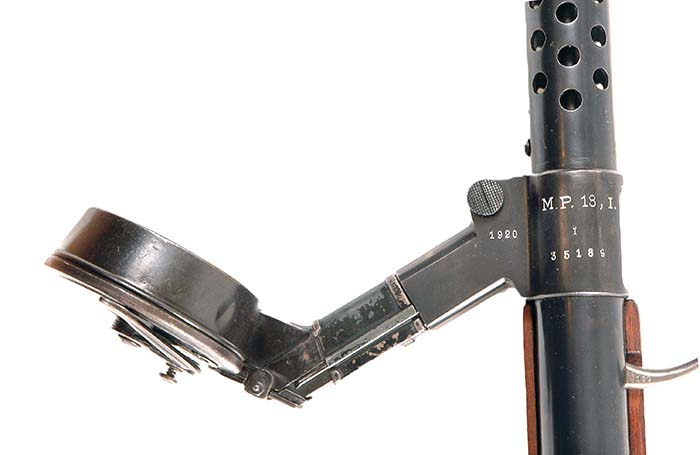
Many of the pre-World War II submachine guns marketed by Germany were exported to South America where they saw service in the 1932-1935 Chaco War between Bolivia and Paraguay.
The M.P. 28.II
The M.P. 28.II machine pistol was a post World War I attempt to further develop the original Schmeisser M.P. 18,I design. The M.P. 28.II was also developed by Hugo Schmeisser, and was manufactured at C.G. Haenel Waffen-und Fahrrad Fabrik. The M.P. 28.II was very similar to the M.P. 18,I, and used the same 20 and 32 round magazines as the modified version of the M.P. 18,I. The M.P. 28.II weapon however had a few additional changes implemented into its design. The M.P. 28.II was capable of semi-automatic or full-automatic fire (select-fire), and had a faster cyclic rate of fire than the M.P. 18,I. The mode of fire selector was marked with a letter “D” for Dauerfeuer (full-automatic fire) and a letter “E” for Einzelfeuer (semi-automatic fire). The rear sight was designed differently, being optimistically graduated for 1000 meters. A larger diameter recoil spring that slipped over the outside rear portion of the bolt was used. The loaded weight of the M.P. 28.II machine pistol was 9.54 pounds. Overall length was 32 inches, barrel length 7.8 inches. The M.P. 28.II was given an illegal service test by the Reichswehr at the Kummersdorf testing facility in 1925.
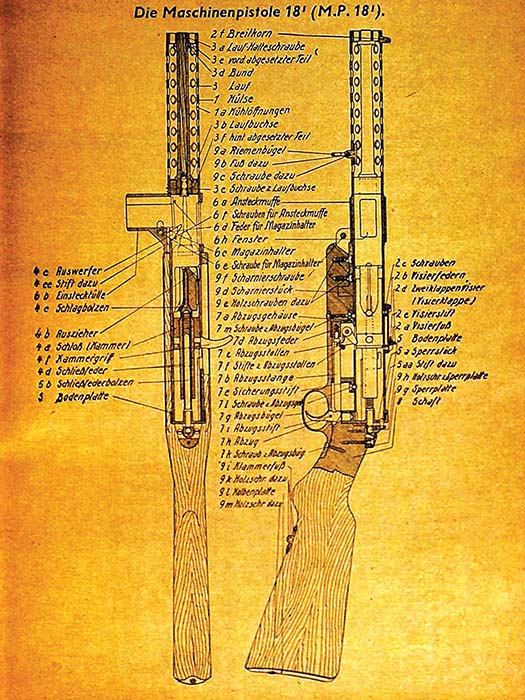
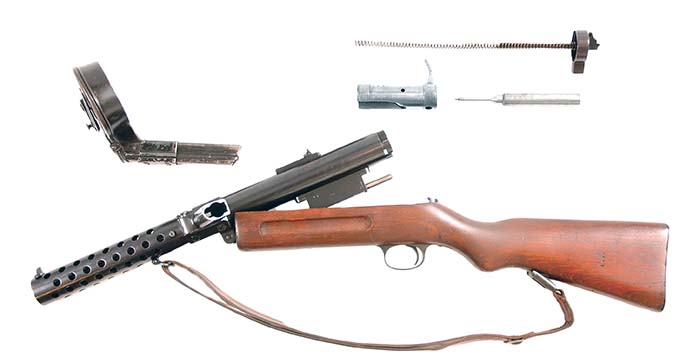
| This article first appeared in Small Arms Review V20N6 (July 2016) |



